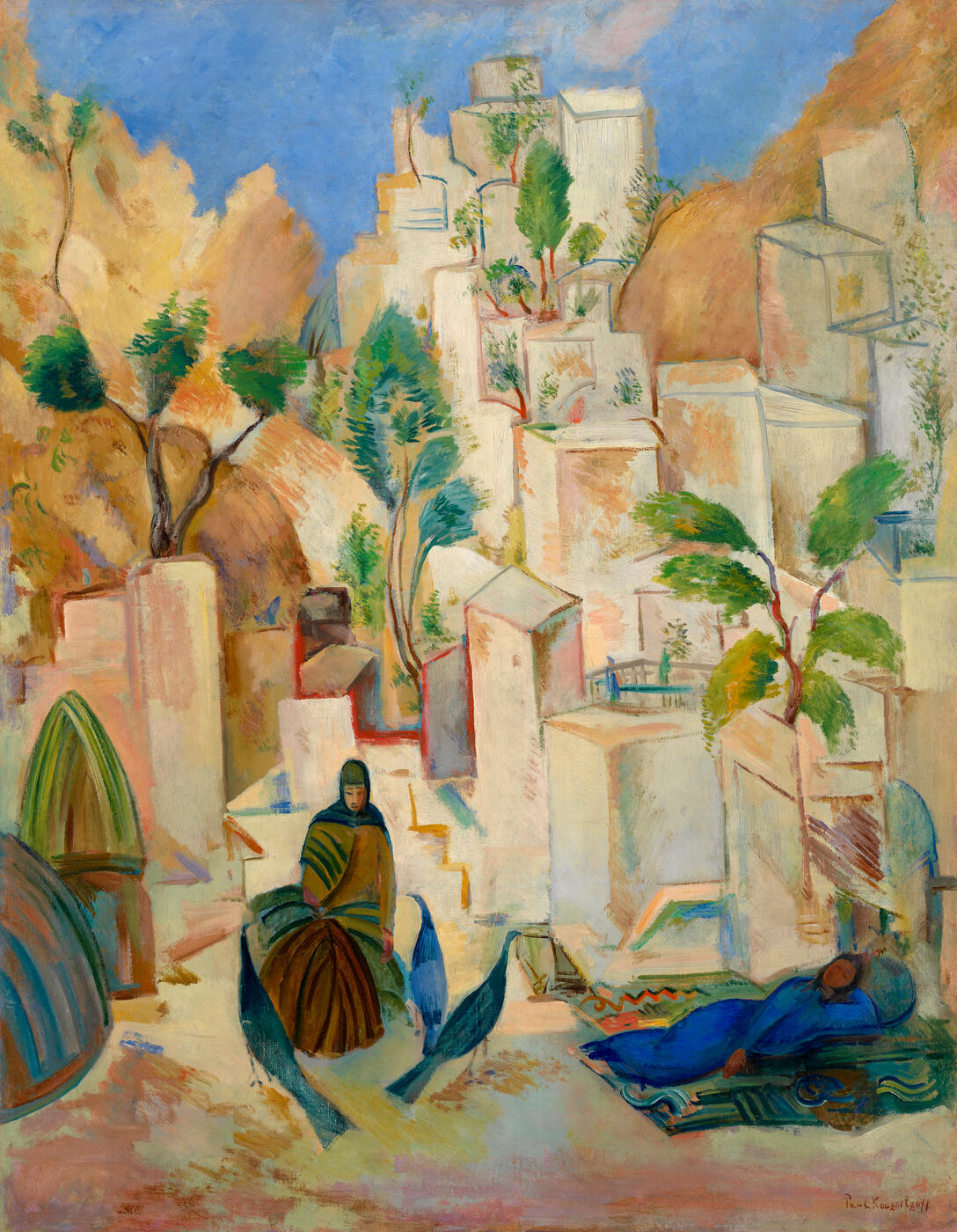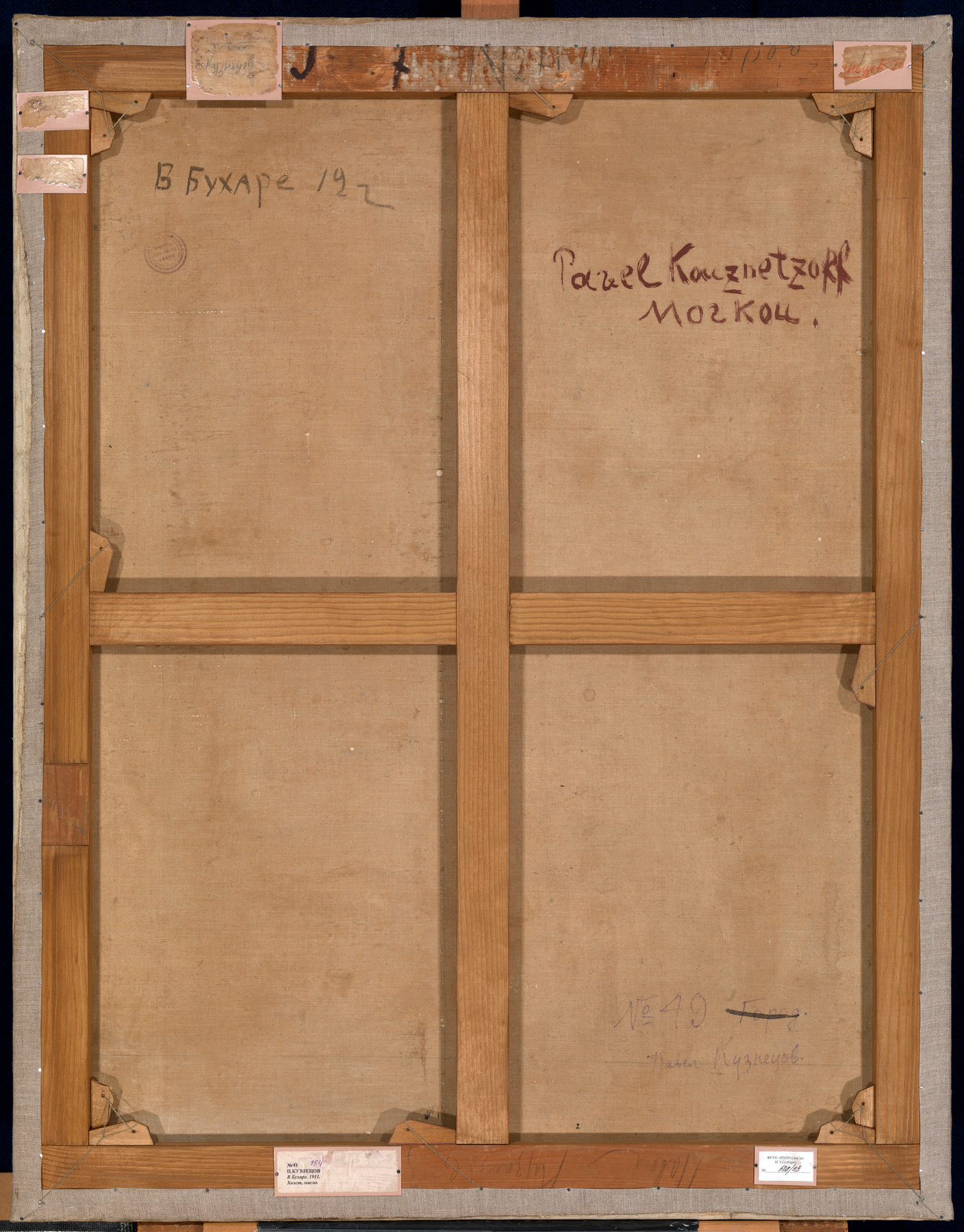4 June 2014 Russian Art Auctions
4 June 2014

* 19. KUZNETSOV, PAVEL (1878-1968)
Eastern City. Bukhara, signed, also further signed, inscribed "Moskou" and in Cyrillic "V Bukhare" and dated 1912.
Oil on canvas, 103 by 80 cm.
1,900,000-3,000,000 GBP
Provenance: Acquired directly from the artists’s studio by Tatiana Kozyreva in 1956.
Private collection, Europe.
Authenticity of the work has been confirmed by the expert V. Petrov.
Authenticity has also been confirmed by the expert I. Geraschenko.
Exhibited: Mir iskusstva, Moscow, 1915.
Mir iskusstva, Moscow, 1917.
Vystavka kartin khudozhnikov Pavla Kuznetsova i Eleny Bebutovoi, Russian Academy of Artistic Sciences, Moscow, May 1923.
Peredvizhnaya vystavka sovetskogo iskusstva v Yaponii, Harbin, Tokyo, Aomori, 1926–1927.
Pavel Varfolomeevich Kuznetsov. 75 let so dnya rozhdeniya. 55 let tvorcheskoi deyatel’nosti, Central House of Art Workers, Moscow, April 1956.
Pavel Varfolomeevich Kuznetsov, Moscow, 1964.
Pavel Kuznetsov. K stoletiyu so dnya rozhdeniya, Moscow, 1978.
Literature: Exhibition catalogue, Mir iskusstva, Moscow, 1915, p. 11, No. 147, listed as V Bukhare.
Exhibition catalogue, Mir iskusstva, Moscow, 1917, p. 7, No. 97, listed as V Bukhare.
Katalog vystavki kartin khudozhnikov Pavla Kuznetsova i Eleny Bebutovoy, Moscow, 1923, p. 5, No. 53, listed as V Bukhare.
Exhibition catalogue, Peredvizhnaya vystavka sovetskogo iskusstva v Yaponii, Harbin, Tokyo, Aomori, 1926–1927.
Exhibition catalogue, Pavel Varfolomeevich Kuznetsov. 75 let so dnya rozhdeniya. 55 let tvorcheskoy deyatel’nosti, Moscow, Sovetskii khudozhnik, 1956, p. 12, listed as V Bukhare under works from 1912.
Exhibition catalogue, Pavel Varfolomeevich Kuznetsov, Moscow, 1964, p. 14, listed as Bukhara under works from 1912.
M. Alpatov, Pavel Kuznetsov, Moscow, Izobrazitel’noe iskusstvo, 1969, illustrated; p. 113, No. 19, listed as Bukhara, incorrectly dated 1911.
L. Budkova, D. Sarabianov, Pavel Kuznetsov, Moscow, Sovetskii khudozhnik, 1975, pl. 44, illustrated; p. 332, No. 225, listed as Vostochnyi gorod. Bukhara under works from 1915–1916.
A. Rusakova, Pavel Kuznetsov, Leningrad, Iskusstvo, 1977, p. 123, illustrated; p. 281, listed as Vostochnyi gorod, incorrectly dated 1913–1914; pp. 125–126, mentioned in the text.
Exhibition catalogue, Pavel Kuznetsov. K stoletiyu so dnya rozhdeniya, Moscow, Sovetskii khudozhnik, 1978, illustrated and listed as Vostochnyi gorod. Bukhara under works from 1915–1916.
Related literature: For the reproduction of the present lot as a postcard, see E. Butorina, Pavel Kuznetsov. Komplekt otkrytok, Leningrad, 1970.
Eastern City. Bukhara is one of the principal and best-known masterpieces of Pavel Kuznetsov’s Central Asian series. Kuznetsov spent several years in the East before the First World War, travelling first across the steppes of Kirghizia and then visiting Central Asia in 1912–1913. “Wishing to continue the theme of the East, which has an affinity for me,” he wrote in his notes, “I decided to delve deeper into Asia: Tashkent, Samarkand and Bukhara. For two consecutive summers I reflected the landscapes and life of this region in my works. The colouration of everything I saw there, so unfamiliar to us Russians, inspired me with new emotions and a new approach to painting, which sprang from the reality around me.”
Bukhara, the most harmonious of the works in Kuznetsov’s Central Asian cycle, offers a certain quintessence of the eastern city. Alongside the best of the steppe pictures from 1911–1912, it represents the summit of Kuznetsov’s creative achievement. Motifs from other Bukhara works reappear in the picture recast, abstracted and purified to a full clarity and simplicity of primary forms.
In Bukhara we find the clearest manifestation of the search for new structural solutions in harmony with the time, a search which is also present, in a milder, veiled form, in Kuznetsov’s other Bukhara works. The artist’s “course towards Derain and Picasso” (in the apt phrase of the art critic, Abram Efros) led Kuznetsov in this picture to a tangible geometrization of forms. And yet Cubism as a world view or even as an intellectual analysis of visible structures remained alien to the artist. While accepting many features of Gauguin’s synthetism, Braque’s decorative qualities, and some of Derain’s painting techniques, Kuznetsov remained sensitive to other important artistic trends of the Russian avant-garde – the influence of the old iconographic tradition and a passion for different variants of Oriental art.
Kuznetsov, in his Bukhara works, limited cubist treatment to those phenomena, which seemed to him to come to meet a type of geometrisation that was more visual than methodological – the architecture of the buildings made from stone or pressed earth, and the jagged outcrops of the mountains around Bukhara. This selectiveness, with which objects are chosen or not chosen for cubist treatment within a single picture, produces a vibrant duality, lending an inner tension to the composition. This duality is present in Bukhara, where only the background of the picture fragments into stereometric protoforms. Kuznetsov on the one hand analytically decomposes inanimate objects in the image, but on the other hand achieves their organic unity and easy mergence with nature. He looks at objects sometimes from above and sometimes from below, and compacts the space of the picture without sacrificing its architectonic quality. Rectangular planes intersect and are deformed, volumes are fragmented, broken lines reach upwards in a repeating, rhythmic drawing pattern. The buildings, rising ledge by ledge, are akin to the icon representation of hills in Novgorod wall paintings.
The colouration of the background is in an unexpected relationship with its complex constructivist treatment – a range of light yellow, pinkish-orange, ochre tones, subtly tinged with the crimson, blue, and glowing red surfaces of the buildings.
In this portrait of Bukhara, which the artist loved above all eastern cities, Kuznetsov brought together his principal impressions of the region, achieving a composite unity of mountains, buildings clinging together, solitary trees, a shred of sky and the women with peacocks, united by the rhythmic organization of the picture as a whole and the colour harmony of golden-yellow and sky-blue tones. All of these elements make Bukhara into one of the most valuable and important examples of the artist’s work.
In the 1970s Budkova and Sarabianov suggested that the picture, from the collection of Tatiana Kozyreva, was in fact painted in 1915 when the artist was revisiting his memories of Central Asia, synthesising what he had discovered there and on his wanderings on the Kirghiz steppes.

Notes on symbols:
* Indicates 5% Import Duty Charge applies.
Ω Indicates 20% Import Duty Charge applies.
§ Indicates Artist's Resale Right applies.
† Indicates Standard VAT scheme applies, and the rate of 20% VAT will be charged on both hammer price and premium.